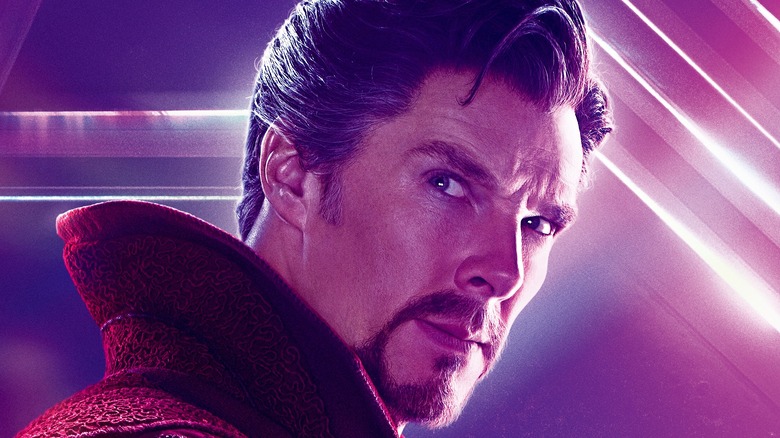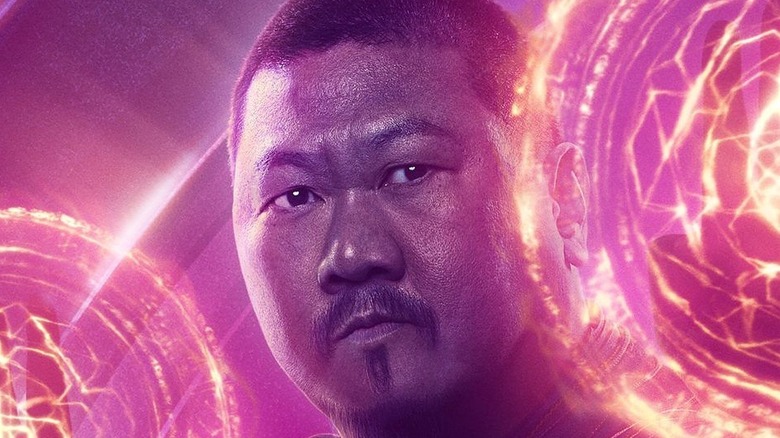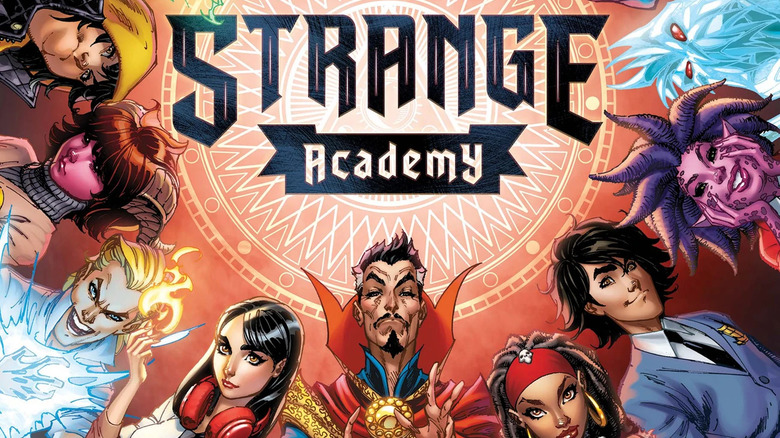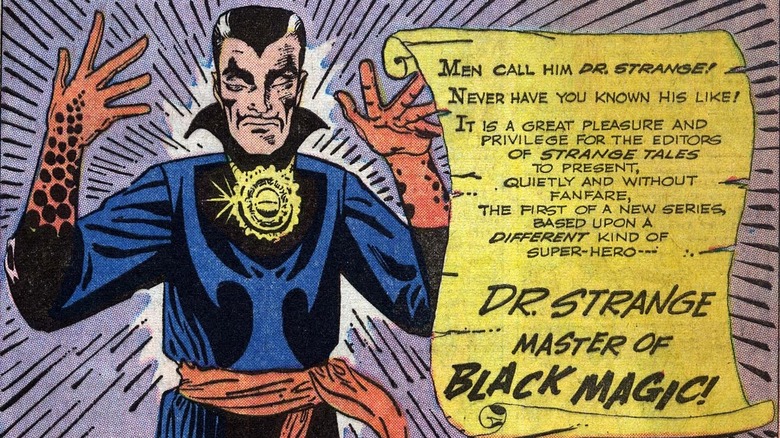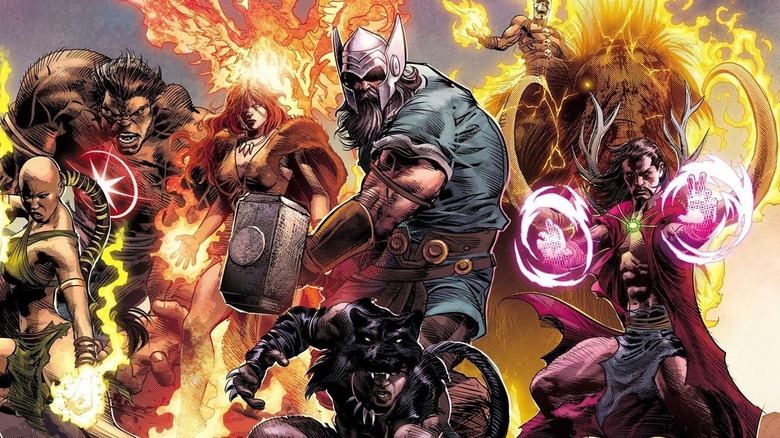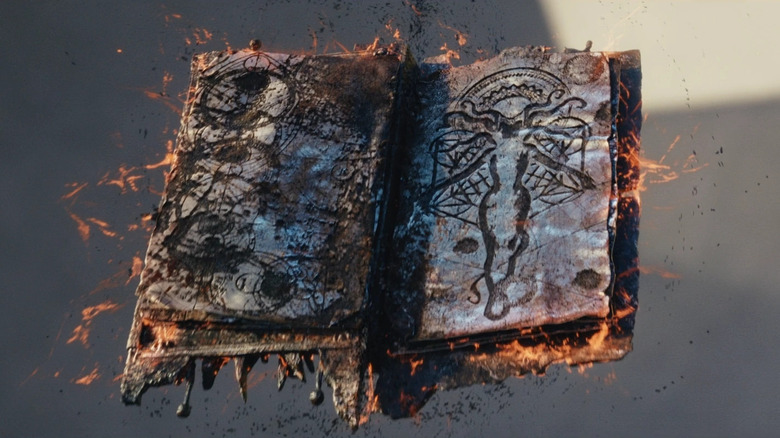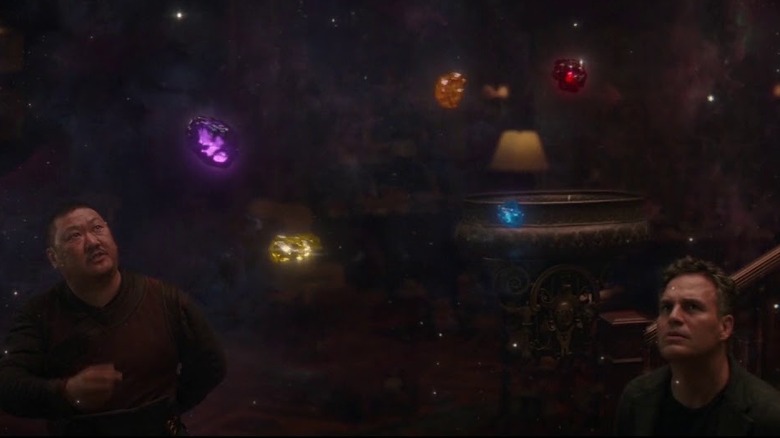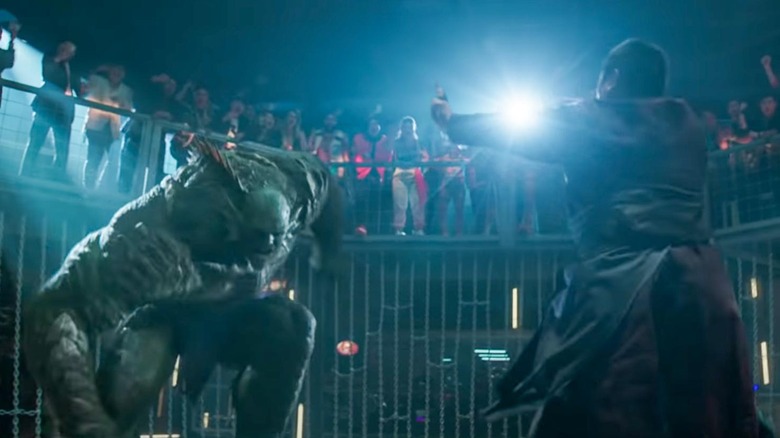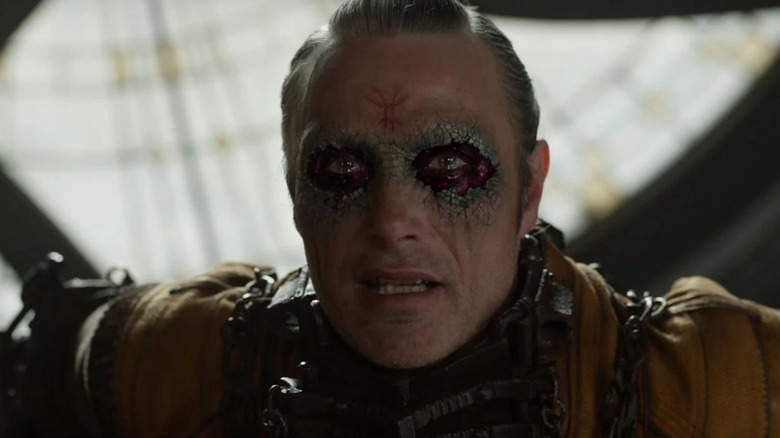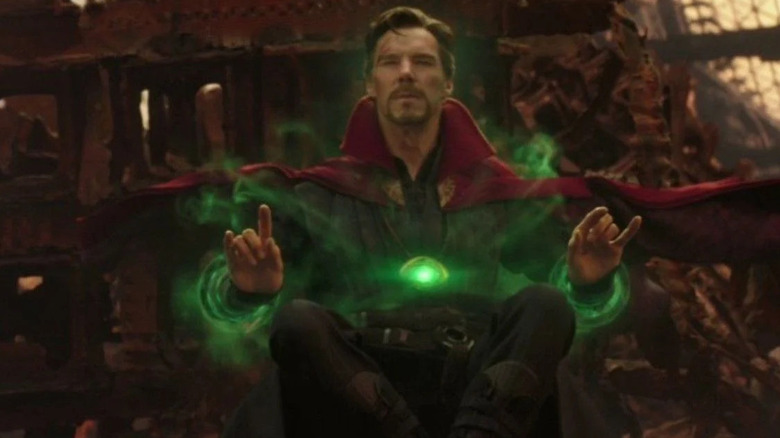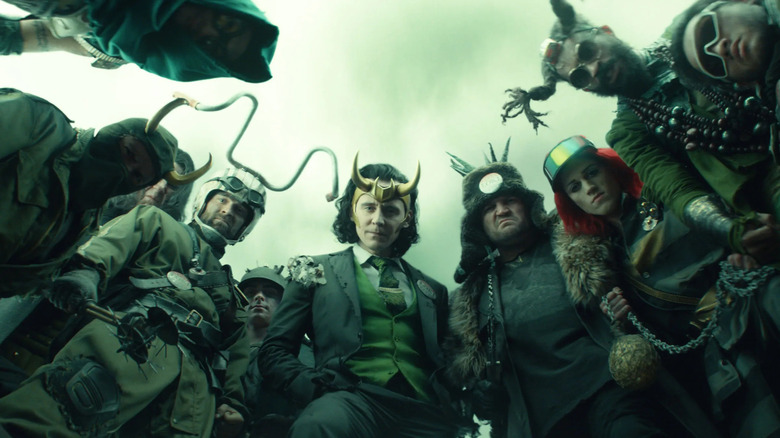The Untold Truth Of The Masters Of The Mystic Arts
With "Doctor Strange in the Multiverse of Madness," the MCU expands with a reality-bending, dimension-hopping, mind-boggling epic. Benedict Cumberbatch returns as Stephen Strange — a complicated hero who at various times bore the titles of neurosurgeon, Sorcerer Supreme, and Stone-Keeper. However, Strange was unburdened of all those responsibilities via crippling injury, being turned to dust, and simply giving it up, respectively.
These days, the one appellation Strange can still confidently include in his supernatural resumé is Master of the Mystic Arts. But he isn't alone in claiming that designation; there is an entire order of people who call themselves the Masters of the Mystic Arts, and the story behind their existence — both in canon and behind the scenes — is as strange as the good doctor's.
With "Multiverse of Madness" shedding more light on the shadowy organization of wizards and warriors, here's an examination of the Masters of the Mystic Arts, a mysterious cabal whose presence in the MCU raises as many questions as it answers.
They're an MCU original
Possibly the single most surprising fact about the Masters of the Mystic Arts is a fundamental fact of their creation: the group was created for the MCU, and has never existed in the pages of Marvel Comics. Dr. Strange was first introduced in a backup story in 1963's "Strange Tales (1951) #110." Yet, in all that time and all those issues, Strange has never been a member of an organization known as the Masters of the Mystic Arts, because no such organization has ever existed.
In 2016's "Doctor Strange" movie the Ancient One (Tilda Swinton), as the Sorcerer Supreme of her time, runs an academy in the hidden city of Kamar-Taj, and Strange became one of her many pupils. In the comics, however, the Ancient One keeps (at most) one apprentice at a time.
As revealed in "Strange Tales (1951) #115," Strange only becomes the Ancient One's disciple by saving the old master from the deadly machinations of a former pupil, Baron Mordo. With Mordo out, Strange begins studying under the Ancient One, eventually reaching a level of skill that allowed him to strike out on his own (aside from the ever-loyal Wong). Only then did Strange begin announcing himself as Dr. Strange: Master of the Mystic Arts.
They made it to comics... sort of
Though the school at Kamar-Taj (with headmaster the Ancient One, professors Wong and Mordo, and scores of budding wizards) was invented for the movies — a kind of MCU-original Hogwarts — a version did find its way into the comics ... well, kinda. Debuting in 2020, the series "Strange Academy" featured Dr. Strange's efforts to establish and maintain a school for young beings from various planets and dimensions in which they can learn to control their innate powers of sorcery.
The series is a reinterpretation of the 2011 series "Wolverine and the X-Men," which followed Wolverine as he reopened a school for young mutants and the unorthodox faculty he employed. Swapping out x-genes for spectral affinities, "Strange Academy" keeps the formula going, as Strange and a motley crew of sorcerers — including Brother Voodoo, Scarlet Witch, and others — teach tomorrow's sorcerers to, well, master their mystic arts.
Given the students' lessons in portals, magic combat, and arcane artifacts, and with the Ancient One even appearing as a faculty member, the Strange Academy feels very comparable to the MCU's Masters of the Mystic Arts. Perhaps the biggest difference between the two, and one that helps make "Strange Academy" a fun read, is that unlike Kamar-Taj's strictly human student body, the Strange Academy welcomes any magical beings looking to master their magic, from fairies to Asgardians to demons and even the son of Dormammu.
What Sorcerer Supreme means
When MCU heads decided to take one of Strange's many sobriquets, Master of the Mystic Arts, and turn it into an entire order of wizards and would-be's, they changed a few major definitions in the Marvel lexicon. Within Marvel Comics canon, Master of the Mystic arts is just one of many titles that Strange bestows upon himself, both to accurately describe his profession and rank, and as a boastful epithet meant to warn potential enemies of his power. Behind the scenes, it was a moniker given to Strange in early appearances to help his comic sell. In fact, the phrase didn't adorn Strange's name until several issues after the sorcerer's debut; in his first few appearances, Strange was labeled "Dr. Strange: Master of Black Magic!"
Strange used Master of the Mystic Arts as a way of signifying his status as one of Earth's greatest sorcerers, second only to the Ancient One himself. Other pupils of the Ancient One, like Baron Mordo and Doctor Druid, whether they "graduated" from his instruction or not, weren't bestowed the title. In the MCU, however, any student who completes their lessons at Kamar-Taj becomes a Master of the Mystic Arts. Instead of meaning "Earth's greatest," as the comic book Strange meant it, the MCU uses Master of the Mystic Arts to in essence say "licensed professional."
Founded by an Avenger?
The 2016 "Doctor Strange" movie, alongside a pair of tie-in comic book preludes, established that the Masters of the Mystic Arts was founded by Earth's first sorcerer, Agamotto. After learning of the existence of other dimensions, the sorcerer began drawing power from them, all the while protecting Earth from any potential threats they might pose. Much of the MCU's wizarding world owes its existence to Agamotto — not just the academy at Kamar-Taj, but the role of Sorcerer Supreme and the Eye of Agamotto, the relic that kept the Time Stone safe. The character exists in Marvel comics, as well, and in that canon, was also one Earth's first Avengers.
Dubbed the "Avengers of 1,000,000 BC," the team not only included Agamotto, but also Odin, a pair of early humans (or close relatives) possessing the universal forces of the Phoenix Force and the Starbrand, and the first Ghost Rider, Iron Fist, and Black Panther. When the team isn't hooking up — with Odin and the Phoenix's fling giving Thor his third canonical mom — they save the prehistoric world from prehistoric Avengers-level threats. It's too bad the other founding Avengers didn't open their own academies and train future "Masters of the Vibranium Arts" and "Masters of the Unpopular TV Series Arts."
They may have caused WandaVision
Following Daredevil's cameo in "Spider-Man: No Way Home" and Kingpin's in "Hawkeye," Marvel's Netflix series now firmly exist within the MCU canon, but the same can't be said for other projects, like the ABC series and various Spider-Man-adjacent Sony films. However, thanks to a series of subtle connections, at least one series, "Agents of S.H.I.E.L.D.," has another link to the MCU — one that may place the blame for the events of "WandaVision" on the shoulders of the Masters of the Mystic Arts.
The chain of connection runs like this: in "Doctor Strange," the Kamar-Taj library plays an important role, keeping mystical knowledge (i.e. spells) centralized and safe. But, as fans noted, the library's collection had one clear absence, suggesting a lost or stolen book. Then, in "Agents of S.H.I.E.L.D.," the famous grimoire known as the Darkhold appeared, which one of the show's EP's said, "feels like it belongs in the library in Kathmandu," i.e. the Kamar-Taj library. The Darkhold then reappeared in "WandaVision," amplifying the powers of Agatha Harkness. Referring to the two series' Darkholds, "WandaVision" director Matt Shakman said that he "would imagine it's the same book."
In the eyes of key creatives behind the shows, then, the Darkhold that Harkness used to manipulate Wanda in the MCU's "WandaVision" is likely the same magic tome that was stolen from the watchful eyes of librarian Wong and the Masters of the Mystic Arts back in "Doctor Strange."
They know more than we've seen
With every appearance of the Masters of the Mystics Arts, whether it be the academy itself, Wong (Benedict Wong), or Strange, it becomes increasingly apparent that the organization knows more about the goings-on of the multiverse than most — perhaps, more than anyone.
Though there is any number of powerful factions in the MCU that hint at far-reaching knowledge bases — for example, Thor revealing that Asgard teaches Groot as an elective language — they all seem to have their blind spots as well. Asgardians had visited Earth for thousands of years and yet never knew that they had sorcerers, as revealed by Thor when he asks Strange, "So, Earth has wizards now?" But the Masters of the Mystic Arts, and they alone, seem to know at least a bit about everything.
They knew about the Time Stone thousands of years ago, knew it to be (as Wong said) an Infinity Stone, and even knew about the other Stones and how they all work. They can sense any powerful force on Earth, be it the activation of the Ten Rings or the presence of an Asgardian like Loki — heavily implying they knew when Earth encountered the Casket of Ancient Winters, the Tesseract, and even the presence of the Eternals. They knew about the multiverse well before anyone else; the Ancient One talks about it in Strange's first movie.
They also seem to be the only ones who know about the special realities they choose to call dimensions, like the Dark Dimension and the Mirror Dimension. They even know the future, as the Ancient One proved to the Hulk during "Endgame."
They are weirdly chill
Whether it is because they possess so much multiversal knowledge or directly in spite of it, the Masters of the Mystic Arts is an oddly lax organization. Multiple movies confirm that the group's members — whether they're the Sorcerer Supreme or just an average wizard — are free to do pretty much anything they feel like. As strange as it may be, once young wizards are taught the secrets of the cosmos, teleportation, conjuration, and inter-dimensional travel, the Masters of the Mystic Arts let them loose on the world, with no real oversight.
In "Shang Chi," Wong — who at that point is the Sorcerer Supreme and therefore burdened with unparalleled responsibility — participates in cage fights against Hulk-level metahumans, seemingly just for kicks. That's the mystic equivalent of the Secret Service letting the President of the United States enter the Running of the Bulls. They also don't seem to mind when members of their order cast spells on each other, as Strange made clear when he told Wong about the spell of forgetfulness he cast on everyone after a full moon party. Strange even held a private meeting with Odin, the King of Asgard, and agreed to let him live on Earth and what's more — keep Odin's location a secret from everyone else, including his fellow Asgardians. If Odin's successor as king were just a hair more militaristic than Thor, that could have led to war between Earth and Asgard, which would be less of a war and more like an extermination.
Questionable moral compass
Similar to how lax the Masters of the Mystic Arts is with its members' hobbies, the association doesn't seem too concerned with how its members use their magic. Though the overarching plot of "Doctor Strange" revolved around the dangers inherent in using dark magic and time magic, the film's characters — on both sides — use it all pretty liberally. Surviving characters only continue to use them in future movies.
The Ancient One repeatedly emphasizes that dark magic is off-limits, then uses it herself. She also emphasizes the dangers of inter-dimensional travel, and then every character in the movie travels through dimensions constantly. Strange is warned about the incomparable dangers in using the Time Stone for any reason, and yet does so whenever he feels like it. Virtually every sorcerer at some point warns another character about the dangers in misusing ancient artifacts and arcane relics, then does it anyway — hence, the multiversal damage in "No Way Home." The most damning instance of all is when Strange defeats Dormammu by breaking all four rules at once: he uses the ancient Eye of Agamotto to control the Time Stone and create an untold amount of time loops while in another dimension, the very dimension from which dark magic originates.
There must be a larger plan
The past few entries in this article, those about the Masters' extensive knowledge and power and their laissez-faire attitude when it comes to morality and self-governance, all point to one of two possibilities: either the Masters of the Mystic Arts are reckless, self-serving, over-powered nihilists who've become bored with life and its protection, or they have a larger plan in motion.
Given the abilities of the Masters of the Mystic Arts (or at least, their Sorcerer Supreme) to see the future, see alternate futures, visit alternate dimensions and alternate universes, and detect essentially any major event on Earth — including the existence of powerful beings — it seems likely that the order could have prevented most, if not all, of the MCU movies' tragedies.
If Strange can trap Loki in an endless free fall within moments of him appearing on Earth, surely the Ancient One could have done the same when Loki visited with an army of Chitauri. The same holds true for the Destroyer in "Thor" or even Thanos himself in "Infinity War." Likewise, if they were aware of the Infinity Stones for thousands of years, why did they leave the Space Stone sitting in a crypt in Norway? Perhaps future sight persuaded them to let certain events play out in service of an ultimate victory.
They're about to get busy
Regardless of how much the Masters of the Mystics Arts know, and whether they're all-powerful or completely inept, one aspect of their existence is certain: they're about to get busy. Very busy.
The events of "Loki" and "No Way Home," quite possibly along with "Ant-Man & The Wasp," "Endgame," "WandaVision," and "What If?" have broken fundamental structures of the multiverse apart. Time, space, and the barriers between alternate times and spaces have all been weakened, and it's clear that the events of "Doctor Strange in the Multiverse of Madness" weaken them even further. Already, one Master has had to seal cracks in the fabric of the multiverse while three alternate Peter Parkers battled three universes' worth of villains. What follows is sure to be worse, and that should frighten the Masters to their core.
Magic will be integral to the characters in "Thor: Love and Thunder" and "Black Panther: Wakanda Forever," as well the upcoming "Blade" film, "Agatha: House of Harkness" series, season two of "Loki", and even "Moon Knight." The MCU property which arguably relies the most on technology and the least on mysticism, the "Ant-Man & The Wasp" franchise, is about to see the titular heroes face off against Kang, the multiversal conqueror last scene in the decidedly mystic "Loki." As mystic heroes and defenders of Earth and its reality, the Masters of the Mystic Arts tribe is in for a challenging few years.
